Ever wondered about the diverse conditions that hyperbaric oxygen therapy can address? This innovative treatment, known for its wide range of HBOT indications, offers significant benefits in medical care.
With years of expertise in the hyperbaric chamber industry, we provide insights backed by science and experience.
Hyperbaric oxygen therapy stands out as a cornerstone treatment for certain medical conditions, offering a breath of fresh air, quite literally, to patients worldwide.
In this guide, we’ll dive deep into the specific indications for hyperbaric oxygen therapy, shedding light on how it can revolutionize patient care in various medical fields.
Keep reading to unlock the potential of HBOT!
1. Understanding the Indications for HBOT
Hyperbaric Oxygen Therapy (HBOT) serves as a significant treatment option across a range of medical conditions, leveraging the power of oxygen under increased atmospheric pressure. This therapy involves patients breathing pure oxygen in a pressurized chamber, which enhances the body’s natural healing processes by delivering high concentrations of oxygen to the bloodstream.
HBOT’s indications are vast and varied, touching on areas from complex wound healing to serious infections, and even conditions involving bubbles of air in blood vessels. Here’s the bottom line, by understanding the specific conditions HBOT is indicated for, healthcare providers and distributors can better tailor their services and offerings, enhancing patient care and outcomes in unprecedented ways.
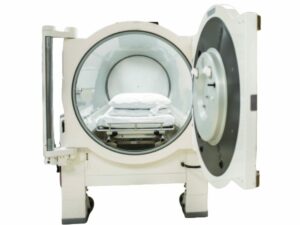
2. Indications for Hyperbaric Oxygen Therapy
Building on our understanding of the indications for HBOT, it’s clear that this therapy plays a pivotal role in modern medicine. Here are the specific conditions where hyperbaric oxygen therapy shines:
Diabetic Foot Ulcers
Chronic wounds, especially in diabetic patients, pose a significant challenge, often resisting conventional treatments. HBOT promotes wound healing by enhancing oxygen delivery to damaged tissues, stimulating the formation of new blood vessels, and supporting the body’s immune response. For countless patients, this therapy turns the tide, transforming the healing process in ways that were once thought impossible.
Radiation Injury
Patients who have undergone radiation therapy may experience delayed side effects, including radiation burns and damage to soft tissues and bones. HBOT helps mitigate these injuries by revitalizing irradiated tissues, encouraging the growth of new blood vessels, and reducing inflammation. The relief and improvement in quality of life it brings to sufferers is profound.
Carbon Monoxide Poisoning
In cases of carbon monoxide poisoning, HBOT proves to be a lifesaver, rapidly removing the toxic gas from the blood while restoring normal oxygen levels. By providing a high-oxygen environment, it prevents long-term neurological damage that can result from poisoning. And the best part is, for many, this immediate intervention marks the difference between life and devastating consequences.

3. Neurological Applications of HBOT
Following the exploration of indications for hyperbaric oxygen therapy, it’s evident that its benefits extend well into the neurological realm. Here are the key neurological applications of HBOT:
Stroke Recovery
HBOT can significantly aid in the recovery process following a stroke. In one study conducted by Neurological Conditions, out of 122 stroke patients 62% of them indicated a better quality of life, which encompassed regained mobility such as the ability to walk again after HBOT. Amazing, right? This therapy offers a beacon of hope, enhancing the quality of life for stroke survivors and offering a pathway to regain lost abilities.
Traumatic Brain Injury (TBI)
For individuals suffering from TBI, HBOT has been shown to reduce inflammation, lessen swelling in the brain, and facilitate the repair of brain tissue. The therapy’s ability to improve neurological function and reduce symptoms associated with TBI can be a game-changer for patients and their families, providing a light at the end of a long, dark tunnel.
Cerebral Palsy
Children and adults with cerebral palsy may experience improved motor functions and reduced spasticity as a result of HBOT. The therapy enhances brain oxygenation, which can stimulate dormant nerve cells and promote better movement control. It’s an emotional journey for many families, witnessing tangible progress and improvements in the daily lives of their loved ones.
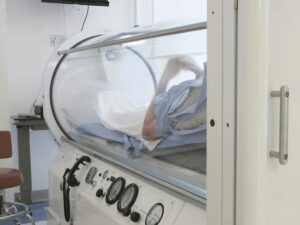
4. The Process of Undergoing HBOT
After delving into the neurological applications of HBOT, it becomes crucial to understand what undergoing this therapy entails. Here are the steps involved in the process of undergoing HBOT:
Step#1 Entering the Chamber
Patients are guided into a hyperbaric oxygen chamber, which can be a large room accommodating multiple patients or a smaller, personal unit for one. The type of chamber used often depends on the facility and the specific treatment plan. It is advisable to always look for the best quality chambers like what OxygenArk is offering.
Step#2 Pressurization and Oxygen Delivery
The chamber is gradually pressurized with pure oxygen or ambient air to levels higher than atmospheric pressure at sea level. This process can cause a sensation similar to ascending or descending in an airplane, and patients are taught techniques to equalize ear pressure. Patients breathe 100% oxygen through a mask or hood, saturating their blood and tissues with oxygen to promote healing. This process is amazing, right?.
Step#3 Monitoring and Communication
Throughout the session, medical staff monitor the chamber’s pressure and oxygen levels, as well as the patient’s response to treatment. Communication with the patient is maintained either through an intercom system or visual signals, ensuring comfort and safety during the entire procedure. The level of attention to patient well-being makes the session feel less like a medical treatment and more like a moment of healing tranquility.
Step#4 Duration and Activities
An HBOT session typically lasts between 60 to 90 minutes, during which patients may rest, sleep, or listen to music. The environment is designed to be as relaxing as possible, with some facilities providing entertainment options like movies or music. This approach helps make the time pass quickly and enhances the overall patient experience, making the therapy not just beneficial but also a pleasant interlude in their day.
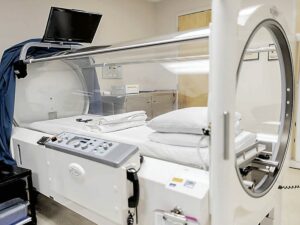
5. Common Side Effects of HBOT and How to Mitigate Them
Understanding the process of undergoing HBOT is crucial, but it’s equally important to be aware of its common side effects and how to effectively manage them, right? Here are the strategies to mitigate some of the side effects associated with HBOT:
Ear Pain or Discomfort
Due to changes in pressure, patients may experience ear pain or discomfort during the pressurization phase of HBOT. To mitigate this, patients are taught techniques to equalize ear pressure, such as yawning or swallowing, similar to what one might do during an airplane takeoff or landing. Using these methods can significantly reduce discomfort and make the experience more pleasant.
Sinus Pain or Congestion
The increased pressure can also cause sinus pain or congestion. To address this patients are advised to avoid undergoing HBOT with a cold or sinus infection, and decongestants may be recommended before treatment to alleviate these symptoms. This proactive approach ensures that HBOT sessions are as comfortable as possible, minimizing any potential for sinus-related discomfort.
Temporary Vision Changes
Some patients report mild, temporary changes in vision after undergoing multiple HBOT sessions. These changes are usually temporary and resolve within a few weeks after the completion of therapy. As a solution optometrists recommend avoiding new eyeglass prescriptions until vision stabilizes, ensuring that patients don’t make unnecessary changes to their eyewear based on these temporary adjustments.
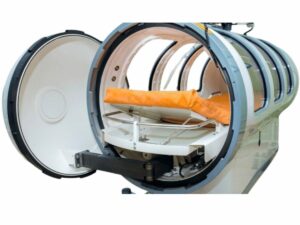
6. HBOT vs. Traditional Treatments
After exploring common side effects and ways to mitigate them, it’s pivotal to understand how HBOT compares with traditional treatments. So please take note of some key comparisons below:
Treatment of Drug-Resistant Infections:
- HBOT: Enhances the body’s ability to fight infections by improving oxygen delivery to tissues. This makes bacteria more susceptible to antibiotics, offering a powerful ally against infections resistant.
- Traditional Treatments: Rely primarily on antibiotics, which may struggle against resistant strains or infections complicated by biofilms, often leading to prolonged or ineffective treatment courses.
Side Effects:
- HBOT: Generally exhibits fewer and milder side effects compared to many drug therapies, making it a well-tolerated option for enhancing treatment regimens without significantly increasing adverse effects.
- Traditional Treatments: Pharmacological options can introduce a range of side effects, from mild to severe, depending on the medication and condition being treated, potentially complicating patient care.
Neurological Rehabilitation:
- HBOT: Offers potential benefits by aiding the recovery and function of brain tissue post-injury. This approach provides hope for patients who have seen limited improvement with standard therapies.
- Traditional Treatments: Often focus on managing symptoms rather than promoting healing, which may limit the recovery potential for patients with neurological injuries or conditions.
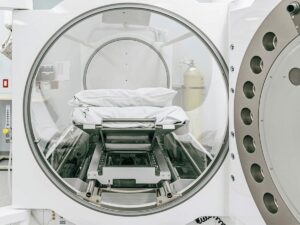
7. Challenges and Limitations of HBOT
Following the comparison between HBOT and traditional treatments, I believe that it’s essential to acknowledge that HBOT, despite its benefits, comes with its own set of challenges and limitations. Here are some critical aspects to consider:
Accessibility and Cost
HBOT facilities are not available in all medical centers, limiting access for some patients who could benefit from the therapy. Additionally, the cost of HBOT can be significant, especially since not all insurance plans cover it for every approved use. This financial barrier can prevent patients from receiving a potentially life-altering treatment.
This table shows how the inherent costs and infrastructure requirements of HBOT directly impact its accessibility:
| Challenge Category |
Specific Challenge |
Description |
Impact on Accessibility |
| Cost Factors |
High Treatment Costs |
The use of specialized equipment and facilities leads to significant operational expenses, often passed onto patients. |
High costs can be prohibitive for uninsured patients or those with limited coverage, restricting access. |
|
Maintenance and Upkeep |
Regular maintenance is required to ensure the safety and functionality of the chambers, adding to ongoing costs. |
Increased operational expenses may reduce the number of facilities capable of offering HBOT, thus limiting availability. |
| Accessibility Factors |
Need for Specialized Facilities |
HBOT requires pressurized chambers, which are costly and complex to construct and maintain. |
This restricts the number of locations where HBOT is available, particularly affecting rural or underserved areas. |
|
Training and Staffing |
Medical staff must receive specialized training to manage HBOT operations and patient care under pressurized conditions. |
The scarcity of qualified personnel can limit service availability and accessibility in areas without specialized training facilities. |
Contraindications
While HBOT is safe for many, there are specific contraindications, for example, untreated pneumothorax or certain types of ear or sinus issues, that can make it risky for some patients. Medical professionals must thoroughly evaluate candidates to avoid adverse effects, making patient selection a critical step in the treatment process.
Limited Awareness and Skepticism
Despite its proven benefits for certain conditions, HBOT is still met with skepticism by some in the medical community. This skepticism can hinder referral rates and limit patient access to HBOT. However, ongoing research and patient success stories continue to bolster HBOT’s reputation, slowly but surely winning over skeptics.
8. 3 Tips for Individuals Considering HBOT
After discussing the challenges and limitations of HBOT, it’s clear to my mind that making an informed decision is crucial for those considering this therapy. Here are some tips to guide individuals through the process:
#1 Undersea and Hyperbaric Medical Society (UHMS)
Seek out facilities accredited by the Undersea and Hyperbaric Medical Society (UHMS). This accreditation indicates that the facility adheres to high standards of care and safety in hyperbaric medicine. Providers should also have certified hyperbaric technicians, healthcare professionals trained in hyperbaric medicine and quality chambers like what OxygenArk is manufacturing.
#2 Insurance Coverage
Understand whether the insurance plan covers HBOT for the specific condition, as coverage can vary widely. For example, treatments for FDA-approved conditions like diabetic foot ulcers may be covered, while others may not. Direct inquiries to the insurance and potential HBOT providers about out-of-pocket costs, which can range significantly depending on the number of sessions required.
#3 60-120 Minutes Session
Each session lasting about 60 to 120 minutes. This commitment can span several weeks, requiring a daily visit to the HBOT center. Scheduling considerations are crucial, especially for those balancing work or other responsibilities. Be aware if the session is shorter or longer within the expected time.
Dive Deeper Into Our Resources
Looking for more diverse product options? Browse through our handpicked selections:
Still haven’t found what you’re looking for? Don’t hesitate to contact us. We’re available around the clock to assist you.
Conclusion
As we’ve navigated through the intricacies of Hyperbaric Oxygen Therapy (HBOT), it’s clear that it can offer a powerful option for healing and treating a variety of conditions. HBOT can make a real difference in patients’ lives, providing benefits that traditional treatments may not match.
For those considering the use of HBOT in treatment regimen, partnering with a trusted and experienced provider is key. OxygenArk stands at the forefront of hyperbaric chamber manufacturing. Contact us today!






